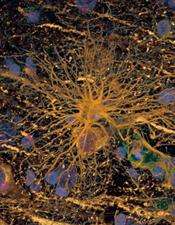Researchers create 'endless supply' of myelin-forming cells

(Medical Xpress)—In a new study appearing this month in the Journal of Neuroscience, researchers have unlocked the complex cellular mechanics that instruct specific brain cells to continue to divide. This discovery overcomes a significant technical hurdle to potential human stem cell therapies; ensuring that an abundant supply of cells is available to study and ultimately treat people with diseases.
"One of the major factors that will determine the viability of stem cell therapies is access to a safe and reliable supply of cells," said University of Rochester Medical Center (URMC) neurologist Steve Goldman, M.D., Ph.D., lead author of the study. "This study demonstrates that – in the case of certain populations of brain cells – we now understand the cell biology and the mechanisms necessary to control cell division and generate an almost endless supply of cells."
The study focuses on cells called glial progenitor cells (GPCs) that are found in the white matter of the human brain. These stem cells give rise to two cells found in the central nervous system: oligodendrocytes, which produce myelin, the fatty tissue that insulates the connections between cells; and astrocytes, cells that are critical to the health and signaling function of oligodendrocytes as well as neurons.
Damage to myelin lies at the root of a long list of diseases, such as multiple sclerosis, cerebral palsy, and a family of deadly childhood diseases called pediatric leukodystrophies. The scientific community believes that regenerative medicine – in the form of cell transplantation – holds great promise for treating myelin disorders. Goldman and his colleagues, for example, have demonstrated in numerous animal model studies that transplanted GPCs can proliferate in the brain and repair damaged myelin.
However, one of the barriers to moving forward with human treatments for myelin disease has been the difficulty of creating a plentiful supply of necessary cells, in this case GPCs. Scientists have been successful at getting these cells to divide and multiply in the lab, but only for limited periods of time, resulting in the generation of limited numbers of usable cells.
"After a period of time, the cells stop dividing or, more typically, begin to specialize and form astrocytes which are not useful for myelin repair," said Goldman. "These cells could go either way but they essentially choose the wrong direction."
Overcoming this problem required that Goldman's lab master the precise chemical symphony that occurs within stem cells, and which instructs them when to divide and multiply, and when to stop this process and become oligodendrocytes and astrocytes.
One of the key players in cell division is a protein called beta-catenin. Beta-catenin is regulated by another protein in the cell called glycogen synthase kinase 3 beta (GSK3B). GSK3B is responsible for altering beta-catenin by adding an additional phosphate molecule to its structure, essentially giving it a barcode that the cell then uses to sort the protein and send it off to be destroyed. During development, when cell division is necessary, this process is interrupted by another signal that blocks GSK3B. When this occurs, the beta-catenin protein is spared destruction and eventually makes its way to the cell's nucleus where it starts a chemical chain reaction that ultimately instructs the cell to divide. However, after a period of time this process slows and, instead of replicating, the cells begin to then commit to becoming one type or another. The challenge for scientists was to find another way to essentially trick these cells into continuing to divide, and to do so without risking the uncontrolled growth that could otherwise result in tumor formation.
The new discovery hinges on a receptor called protein tyrosine phosphatase beta/zeta (PTPRZ1). Goldman and his team long suspected that PTPRZ1 played an important role in cell division; the receptor shows up prominently in molecular profiles of GPCs. After a six-year effort to discern the receptor's function, they found that it works in concert with GSK3B and helps "label" beta-catenin protein for either destruction or nuclear activity. The breakthrough was the identification of a molecule – called pleiotrophin – that essentially blocks the function of the PTPRZ1 receptor. They found that by regulating the levels of pleiotrophin, they were able to essentially "short circuit" PTPRZ1's normal influence on cell division, allowing the cells to continue dividing.
While the experiments were performed on cells derived from human brain tissue, the authors contend that the same process could also be applied to GPCs derived from embryos or from "reprogrammed" skin cells. This would greatly expand the number of cells potentially derived from single patient samples, whether for transplantation back to those same individuals or for use in other patients.














